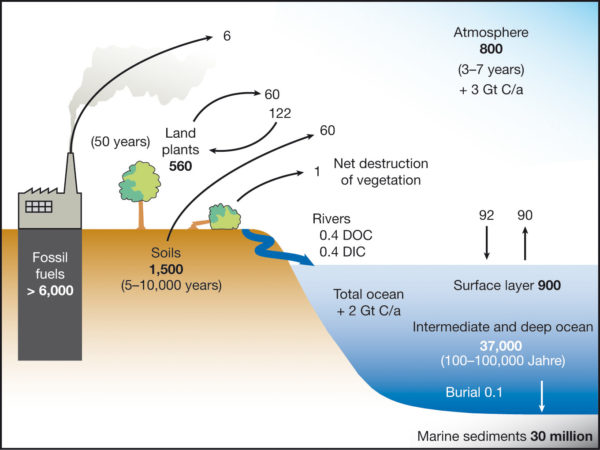Climate Change CO2 Kenaf
Climate change, CO2 and Kenaf? Let me start off saying too much of anything in a specific loaction is not a good thing. Too little of that same thing in a specific location is also not a good thing. We have according to some too much CO2 in the atmosphere. Many of us have thought that this meant the "upper atmosphere" only. Too look at and understand accurately we need to see that atmosphere is located above our soil and water surfaces.
Carbon dioxide mixes evenly through the atmosphere. But the atmosphere as a whole is densest near the ground, so a cubic foot of air at ground level will contain more carbon dioxide molecules than a cubic foot of air high up in the sky.
Since CO₂ is the main source of food for plants, increasing levels of it directly stimulate the photosynthetic rate of most plants.
Is carbon dioxide good for organisms?
It is essential for the survival of most living organisms and cycles in the ecosystem, through respiration (aerobic and anaerobic), photosynthesis, and combustion. Carbon dioxide plays an important role in the regulation of earth's temperature, and is one of the greenhouse gases.
Carbon dioxide is a gas found in the air; plants can take in this gas through tiny holes in their leaves. Once they have water and carbon dioxide, they can use energy from sunlight to make their food. The leftovers from making the plant food is another gas called oxygen.
Through the process of photosynthesis, plants assimilate carbon and return some of it to the atmosphere through respiration. The carbon that remains as plant tissue is then consumed by animals or added to the soil as litter when plants die and decompose.

Source for this photo and additional information on the subject. Real Science
One thing all scientists working in the field can agree upon is that a variety of practices are available that can avoid greenhouse gas emissions associated with our current agricultural system: reducing food waste, shifting towards plant-based diets, improving nitrogen efficiency on crops, and reducing on-farm energy use. These efficiency improvements are all fully compatible with regenerative agriculture. So why should the scientific community create artificial silos to decouple emission reductions from carbon removal? Regenerative agriculture practices can – and must – do both, especially when one considers that the main mechanism for the improvement in soil health, a principle that all soil scientists agree upon, is putting organic matter back into the soil.ext... Excerpt from One Earth
Topsoil ranges from 0.5% to 3.0% organic carbon for most upland soils. Soils with less than 0.5% organic C are mostly limited to desert areas. Soils containing greater than 12–18% organic carbon are generally classified as organic soils.
Balancing CO2
Most of us know that humans and animals and many beneficial microbes depend on oxygen for thier survival. Too much CO2 in the atmosphere and not enough oxygen makes it obvious that this out of balance situation would result in catstrophe.
On site additions of organic matter can come from animal manure, plant roots and plant residue.
Balancing CO2 on site is better than off site additions and make more sense when input costs and time are factored in.

Kenaf and Balancing CO2
Kenaf is known to be one of the top crops for carbon sequestration during it's growing process, and roots that are left in the soil after harvest add to the soil organic matter to feed the microbial communities that help build heathy soil.
So when looking at balancing CO2 we should first focus on the percentage of soil organic matter in our soils. To do this get the soil test that provides a complete picture of your soil including organic matter and should be performed before planting each year. The Complete Soil Package
Kenaf Beyond The Soil
Besides all of the soil benefits kenaf provides there are many more when you look at kenaf as a source material for manufacturing many different products. Kenaf wood core chipped up is ready to use for horse bedding as well as for other pets. The wood core is also one of 3 ingredients to build walls for homes and has excellent benefits as a mulch. With these uses comes jobs and careers as well as the demand for more farmers getting involved with kenaf as a rotational cash crop. Processing centers will need personnel to operate equipment and machines. Truckers will have payloads to deliver and when kenaf is used for upcoming technologies high storage capacitors to replace the expensive and toxic results of batteries etc. we will begin to see our communities thrive that are kenaf and regeneratively focused.
Pollution Versus CO2
Let's first define pollution - the presence in or introduction into the environment of a substance or thing that has harmful or poisonous effects.
Poison or toxin are terms used to describe the same things.
The toxicity of a substance depends on three factors:
1. its chemical structure
2.the extent to which the substance is absorbed by the body
3. and the body's ability to detoxify the substance (change it into less toxic substances) and eliminate it from the body.
This goes beyond just the human body, where water, soil, plants, animals, atmosphere etc. And since all of these things are connected and can influence the health of the others kenaf can play an important role in health in each of these areas.
Kenaf can also remove toxins and heavy metals in the soil
The Focus
So should we be focused on CO2 reduction and climate change or putting CO2 where it is beneficial and regenerative? Should our focus be on the elimination of pollution and toxicity or building strong and healthy environments that can handle it in a regenerative manner?
Recent Articles
-
Investing-strategy
Dec 11, 25 07:51 AM
Investing-strategy for a new industry can be risky doing it the old way. Proposed new investing strategy in the kenaf industry the new paradigm? -
Sale Ends at Midnight
Dec 04, 25 12:00 AM
Save $10 on new book release if ordered before midnight 4 December 2025. Kenaf The New Rotational Cash Crop You Never Heard Of by Bob Lawrason Founder, CEO Kenaf Partners USA. Your guide to buying and… -
Kenaf Seed Oil Industries
Nov 23, 25 09:12 AM
Food fuel and sealers in everyday use. R&D on seed oil production and byproducts
